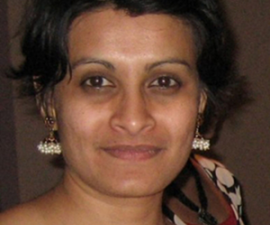

Research Bio
Sai Balakrishnan is an Associate Professor of City and Regional Planning, in a joint appointment with DCRP and GMS (Global Metropolitan Studies). Her research and teaching broadly pivot around global urban inequalities, with a particular focus on urbanization and planning institutions in the global south, and on the spatial politics of land-use and property. She has worked as an urban planner in the United States, India, and the United Arab Emirates, and as a consultant to the UN-HABITAT, Nairobi. Her work has been published in the International Journal of Urban and Regional Research, Urban Studies, Pacific Affairs, Economic and Political Weekly, and in edited book chapters. Her research has been quoted in media outlets, including The Guardian and Open Magazine.
Balakrishnan’s recent book, Shareholder Cities: Land Transformations along Urban Corridors in India (University of Pennsylvania Press, 2019) explores new spatial forms of urbanization by focusing on land contestations along infrastructural / economic corridors in liberalizing India. The book explores the production of private mega-enclaves amidst agricultural fields along these corridors. These corridor urbanizations defy our familiar binaries of city and village and our inherited disciplinary silos of agrarian and urban studies. Instead, the book shows how current urban development accretes onto older histories of agrarian capitalism, thus constituting processes of what Balakrishnan calls “recombinant urbanization.”
Balakrishnan is now focused on two current research works. The first is comparative research on the transfer of development rights (TDRs), a new land (and air) commodification instrument, in Mumbai and Sao Paulo. The TDR program is a fundamental reconceptualization of landed property. The TDR program involves delinking development rights, or air rights, from a specific plot of land, and moving these air rights across space, so they can be stacked onto another plot of land. This research is interested in some key questions. First, how the mundane land-use instrument of TDR opens up fundamental questions on “what is land?” What do we mean by land-use planning, when what is being planned is not terra firma, but delinked air rights. Second, what kinds of windows do these TDR programs open up into the wider processes of fiscal austerity, public services, and land commodification? Third, what are the new geographies of inequalities in these vertical cities?
The second research, in collaboration with Arindam Dutta (MIT), focuses on India’s new economic corridors, namely the Delhi-Mumbai Industrial Corridor and the Indo-Gangetic Eastern Dedicated Freight Corridor, to understand the geographies of uneven development in postliberalization India. One of the key aims of the research is to unpack the seemingly “technical” understanding of infrastructure, and instead to reveal its role as a political and socializing instrument through which “the state” is captured by caste constituents. The research historicizes contemporary infrastructure corridors within longer path legacies that trace back to colonial-era irrigation canals, and is keen on analyzing how caste and capitalism co-constitute each other in India.
Research Expertise and Interest
spatial forms of urbanization, land-use changes
